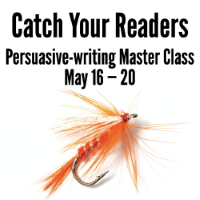Position your message in the reader’s best interest
Too often, communicators think the topic is the topic. But the topic is never the topic. The reader is always the topic.

Here’s how it works, in examples from our recent Catch Your Readers Master Classes:
Before:
Want to know more about the XYZ solution?
Why would I? What’s in it for me?
You can now save time and money by predicting when your print/scan devices will fail, with our predictive support solution.
Before:
The new XYZ integration is a smart, compelling solution for your business that will allow you to drive sales productivity and maximize your current technology stack.
Don’t bury the benefits behind an 8-word description of your product. Instead, lead with the WIIFM:
Streamline sales processes and get more value out of your investment with the new XYZ integration.
Before:
With our updated ABC, you can now measure each engagement and iterate based on actual data.
That sounds helpful. Why not lead with that WIIFM?
Close more deals and find out what’s working with our updated ABC. You can measure results down to the click.
Answer What’s In It For Me (WIIFM).
As a reader, which would you rather read: the befores or afters? About the product or service or about how the product or service will help you?
How can you reframe your message to focus on the WIIFM?
How do you write messages that readers want to read?
If you want to Catch Your Readers, you need to think like a reader. Then you need to use the bait your reader likes, not the bait you like.
 So what’s the bait the reader likes?
So what’s the bait the reader likes?
Learn a four-step process for making your message more relevant, valuable and rewarding to your audience at Catch Your Readers, our persuasive-writing workshop starting May 16.
There, you’ll learn the formula readers use to determine which messages to read. Discover two rewards you can use to boost audience interest in your message. And learn a magic word that focuses reader attention on your message.
Save up to $100 with our group discounts.
